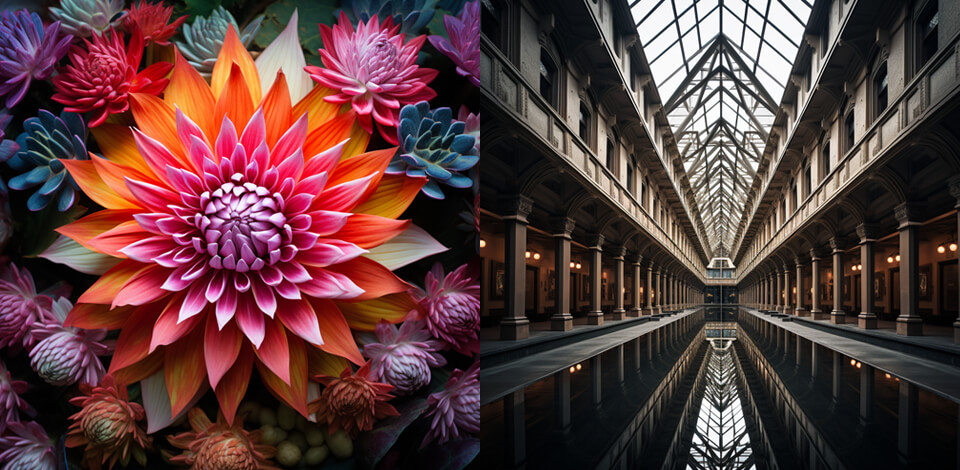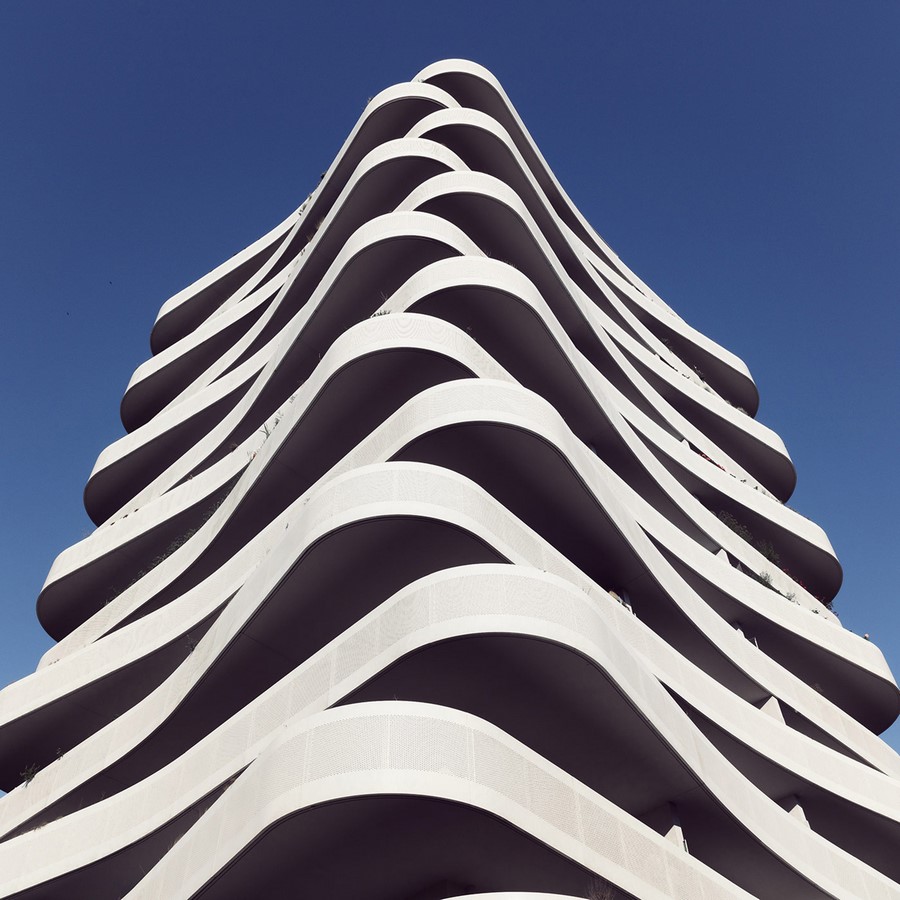
Symmetry in photography appears when parts of your composition contain identical elements mirroring each other and creating a perfectly balanced photo. This technique is an effective tool for achieving visually pleasing and proportional composition.
Creating a sense of balance across the field of view is not possible without symmetry. The viewer won’t struggle to find the balance in what he/she sees.

A vertical line of symmetry goes down an image thus dividing it into two identical halves. Each part reflects the other in detail. If you decide to fold the pic along a vertical axis, both parts should perfectly coincide.
Vertical symmetry works well for shooting a single building or a row of buildings on any side of the street, as it allows a photographer to represent their dimensions, shape, and the way they are positioned in a pic ideally.

This type of symmetry is especially popular in nature photography and is very easy to find in nature.
It is created by the line that passes through the scene from right to left, dividing it into equal halves that mirror each other along a horizontal axis.

The radial symmetry happens when something is equally symmetrical around a central point, which results in a circular or spiral pattern. The object that is being shot must have a round shape and fill the whole frame. This can be flower photography, shells starbursts, or pics where ripples radiate outwards in a body of water.

Bilateral symmetry is comparable to vertical symmetry. However, the divided parts do not necessarily need to be absolutely identical. This is about creating a perfect balance of elements on both sides of a central line.

This type of symmetry is where one-half of the object reflects the other half of the object creating a proportional composition. Use mirrors, water surfaces, or other reflective materials to make symmetry photos.
Those who know how to find your angles on pictures and set the right lighting can even create a reflection using a glass of orange juice placed on a glass table.

Asymmetrical balance involves using elements with unequal weight on both sides of a composition to achieve a sense of balance. Take note that the halves of images do not necessarily need to be identical.
For instance, it is possible to balance a small object in the foreground with a larger object in the background.
Try to discover various types of symmetry in the world around you to be able to make eye-catching symmetry photography.
To get some inspiration, take a stroll around your neighborhood observing some symmetrical scenes around you. Here are a few ideas on how to find symmetry in nature for a perfect shot.

In nature everything is symmetrical. From plants, and animals to geological formations – all the naturally occurring patterns boast perfect proportions and balance.
Even a bird flying above a still lake whose appearance reflects on a water surface can add a sense of drama to your pic, making it more appealing to viewers.
Of course, animals are more difficult to work with than people, as they often refuse to pose for the camera. However, shots featuring our furry friends are unique and original, so the extra effort is worth it.

When it comes to increasing the sense of symmetry in images at post-production, cropping is a key technique. It allows you to bring the focus on the desired objects within the frame.
Creating your mini studio for taking symmetrical photos anytime you want is a brilliant idea.

Insect photography is a perfect genre for creating vertical symmetry. Attach macro lenses to your device to get really close to an insect and achieve an ideal balance along a vertical axis.
Symmetry is all about calmness and balance, while pics featuring a spider cause the opposite feeling, which results in highly contrasted composition.

Professional photographers tend to use drones for photography architecture, agriculture, and infrastructure. In areas with no restrictions on flying a drone, discover various forms of symmetry to take fabulous pics.
A perfect example of vertical symmetry could be a shot of a road with dense forests on both sides. Photographing radial symmetry, such as domes, fenced pens or bunkers can also deliver amazing results.

If you are not sure what location to choose for your symmetry photography, an urban area with unusual buildings will be a perfect option. You need to find patterns in buildings and the space around them to make high-quality architecture photography. It is important to focus on colors, height, depth, and details. You can also experiment with photographing buildings at different times of the day.

We usually associate symmetry with unliving beings but it often involves people. Self portrait photography is an ideal genre for discovering new compositional solutions.
Since you will not only need to pose but also focus on symmetry, it is better to choose a quiet place for shooting. The more comfortable you feel, the better the photos will be.

The human brain perceives the world as a three-dimensional notion, whereas photos only feature two dimensions. Therefore it would be beneficial to use leading lines in photography to add space and depth to your pics.
When shooting compositions using leading lines, you had better use a wide-angle lens as it is easier to achieve depth with it.
Whether shooting in nature or the urban world, you won’t have trouble finding leading lines for your shots. These could be trees, waves, the horizon, roads, bridges, etc. It is possible to create visually dynamic compositions from everything.
There are different types of symmetry, namely horizontal, vertical, and radial, etc. Thanks to this technique, your photos will look visually pleasing, balanced, and consistent.
Using a tripod is a good way to ensure symmetry in your photos. A tripod keeps the camera stable and prevents wobbly or tilted lines and angles. Proper use of leading lines, incorporating reflections, and following patterns for creating symmetrical compositions.
This technique allows photographers to create well-balanced compositions. Using it, you can easily shoot stable, static, and bold images.
No, in photography, symmetry does not always have to be perfect. Partial symmetry or even asymmetrical photography can look beautiful if you use the right technique and composition.
Symmetrical images can be easily divided into identical halves vertically, horizontally, or radially.
Symmetry is all about consistency and balance within the pattern. Some parts of the pattern mirror each other, whereas others are different.